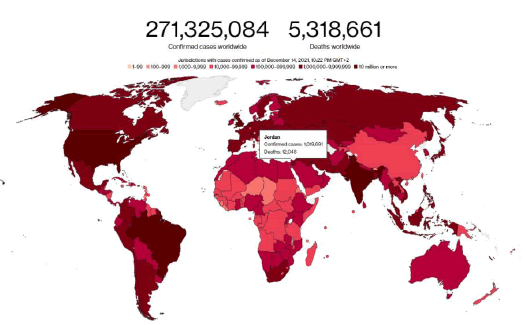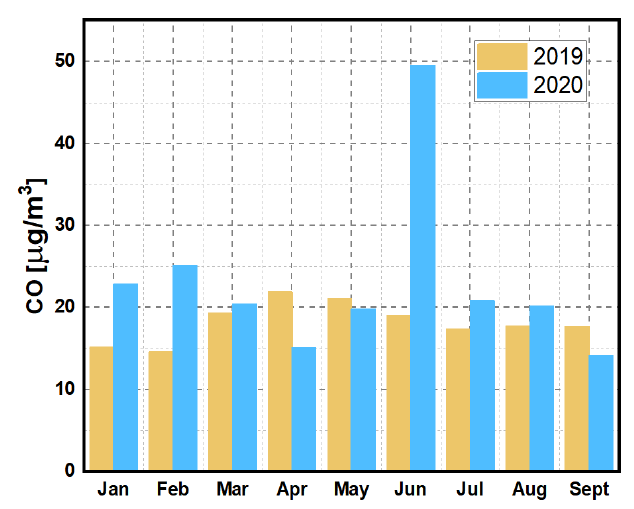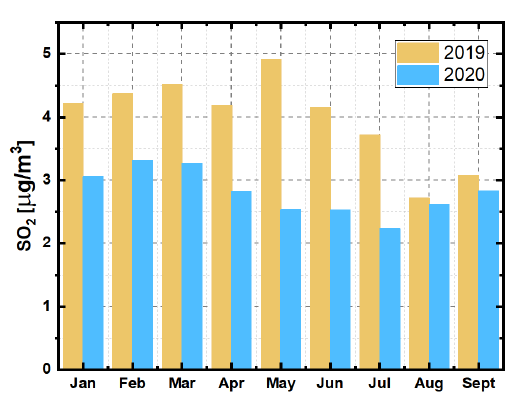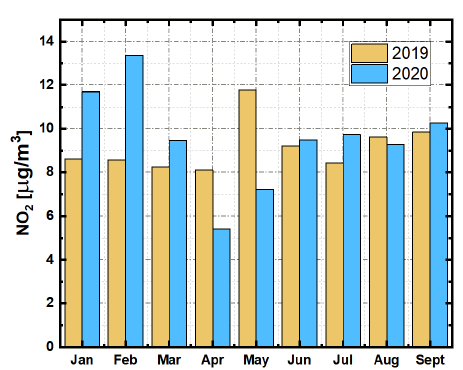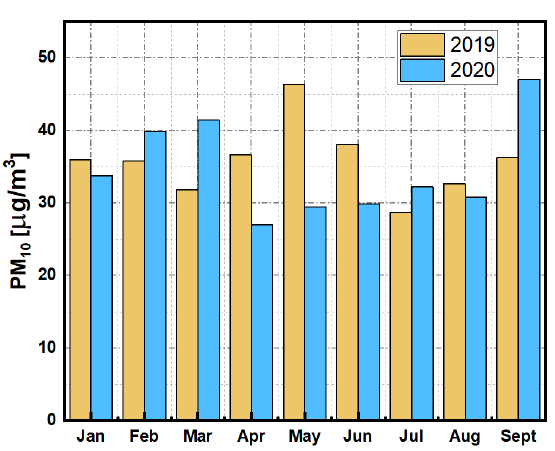Research Article: 2022 Vol: 21 Issue: 4S
Impact of COVID-19 on the Natural Environment: Evidence from Jordan
Hadeel Abdellatif, Applied Science Private University (ASU)
Fadi R. Shahroury, King Abdullah II School of Engineering, Princess Sumaya University for Technology (PSUT)
Citation Information: Abdellatif, H., & Shahroury, F.R. (2022). Impact of COVID-19 on the natural environment: Evidence from Jordan. Academy of Strategic Management Journal, 21(S4), 1-7.
Abstract
The extant research has primarily investigated the negative impacts of the COVID-19 pandemic on our lives and ignored its positive impacts on the environment. Aside from the disastrous impacts of COVID-19 on public health and global economic activities, it is without a doubt that planet Earth is breathing again. This study aims to discuss the effect of COVID-19 on the natural environment, particularly in Jordan. By comparing the concentration of various pollutants including; Carbon Monoxide (CO), Sulfur Dioxide (SO2), Nitrogen Dioxide (NO2) and Particulate Matters (PM10) in 2019 and 2020, our findings show that there is a significant relationship between COVID-19’s restrictive measures and the improvement of air quality. Significant reduction in the concentration of CO, SO2, NO2 and PM10 were reported during COVID-19 lockdown.
Keywords
Covid-19, Restrictive Measures, Environmental Pollution, NO2, SO2, CO, PM10
Introduction
The outbreak of COVID-19 at the end of 2019 in the city of Wuhan, China caused by the Severe Acute Respiratory Syndrome Coronavirus 2 (SARS-CoV-2) as a causative agent of pneumonia, has been considered one of the worst global health emergencies (Abdellatif & Shahroury, 2021; Basheti et al., 2020). Due to its rapid spread across countries and continents, its highly infectious nature and its high mortality rate, the World Health Organization (WHO) declared it a pandemic on 11th March 2020. As illustrated in Figure 1, Over 271 million confirmed cases and more than 5 million deaths has been reported globally by WHO on 14th December 2021.
It is believed that the origin of COVID-19 is zoonotic and that it spreads through chains of human-to-human interaction. Since there has been no specific treatment for the virus until now (Abdellatif & Shahroury, 2021), the only way to prevent or slow down its spread is by cutting the transmission route (Bonati et al., 2021). Therefore, countries worldwide have implemented many restrictive measures to control the spread of the virus ranging from social distancing, to quarantine and complete lockdown. The main priority for the WHO has been saving people’s lives through massive COVID-19 screening tests, treating infected people, imposing social distancing and hygiene practices and developing effective vaccines and treatment protocols (Kumar & Nayar, 2021). Though, The United Nations (UN) is speculating the broader consequences of the COVID-19 pandemic beyond the health burdens and is currently considering this pandemic as a social, human, and economic crisis (United Nations, 2020). However, slight attention was given to the non-health consequences of COVID-19. For instance, few studies have analyzed the impact of COVID-19 on the natural environment (Zambrano et al., 2020).
Aside from the disastrous impacts of COVID-19 on public health and global economic activities, it is without a doubt that planet Earth is breathing again; the restrictive measures of COVID-19 have led to a significant drop in energy consumption and emissions along with a restoration of the Ozone layer (Dai et al., 2020; Tanzer-Gruener et al., 2020; Xiang et al., 2020) which could be seen as “a blessing in disguise” (Muhammad et al., 2020). It is also believed that the consequences of the COVID-19 pandemic will vary widely between developed and developing countries (United Nations, 2020). While there is a plethora of research about this pandemic in developed countries, little research has explored the impact of it in developing countries and even there is a dearth of research in the Middle Eastern region. Therefore, this paper investigates the impact of the COVID-19 pandemic and its restrictive measure on the natural environment in Jordan; a developing country in the Middle East, based on the concentrations of four main air pollutants; CO SO2, NO2, and PM10.
Conceptual Background
Air Quality
Air pollution is a critical global problem. Serious concerns have been raised during the past decades about air quality across the world. It is believed that there is a dynamic linkage between air pollution and health problems. Levels of air pollution have reached a worrying limit; it has been reported that 95% of humans breathe polluted air and that 4.6 million people worldwide die every year because of poor air quality (Muhammad et al., 2020; Rupani et al., 2020). CO, SO2, NO2 and PM10 are four main pollutants that are considered as indicators of air quality.
CO is a toxic, colorless, tasteless and odorless gas that is mainly emitted from the incomplete burning of carbon-containing fuels including; coal, gasoline, wood, oil and natural gas. The main source of CO is vehicular emissions and indoor fuel-burning appliances including; boilers, heaters, grills and gas stoves. CO causes headache, nausea, dizziness and vomiting. High doses of CO restrict the blood’s capability to carry oxygen to cells and organs, leading to suffocation. Moreover, exposure to moderate and high levels of CO over long periods increases the risk of heart diseases and those who survive may suffer long-term health implications (Wu et al., 2019). Moreover, SO2 is a colorless and reactive gas with a strong odor that is mainly produced from fuel combustion. It has a substantial negative effect on human health; it causes skin inflammation, irritation of the respiratory system, cardiovascular complications, breathing difficulties, lung failure leading to death. Additionally, it is a major cause of acid rain and soil acidification leading to plant diseases. It is highly reactive with other chemicals found in the air and has the ability to change into a fine particle that can easily move and get into the lungs of both humans and animals (Xu et al., 2019).
Another air quality indicator is NO2 which is a highly reactive gas with a nasty smell that is primarily produced from burning of fossil fuels. Transportation and vehicular emissions are main sources of NO2. It is very lethal to human health and can cause cellular inflammation, bronchial hyper-responsiveness and respiratory complications leading to death (Hashim et al., 2020). Finally, PM10 is an inhalable aerosol that has less than 10μm diameter. It originates from various emission sources such as; industrial activities, refuse burning and power plants. It can weaken the immune system and suppress its ability to fight infections and can cause serious health problems such as; high blood pressure, asthma, strokes, bronchitis, lung cancer and lead to death (Abdellatif & Shahroury, 2022).
COVID-19 Pandemic-The Jordanian Context
In Jordan, the first confirmed COVID-19 case was reported on 2nd March 2020, in the capital Amman. Later, on 15th March 2020 more cases were confirmed and thereafter, big cities such as Irbid and Zarqa became the epicenters of COVID-19 spreads in Jordan. On 17th March 2020, 40 cases were reported and the Jordanian government announced a complete lockdown and activated the Defense Law issued in 1992 whereby all public and private institutions were closed except the health sector and other vital sectors, citizens were prohibited from leaving their homes unless of extreme necessity, all educational institutions were closed, gatherings of more than 10 people were forbidden, movement between cities and governorates were prevented, all non-emergency operations and patients visits were canceled, all forms of public transportation was stopped, all malls and commercial centers were closed and finally quarantine camps were established for all passengers entering the Jordanian land border crossing (Abdellatif & Shahroury, 2022; Abdellatif, 2021; Abu-Farha et al., 2021; Abazid et al., 2021).
As the epidemiological situation improved, the Jordanian government started to ease the restrictions, adapt to the new changes caused by the outbreak of COVID-19 and re-open sectors. By late April 2020, the government re-opened the public transportation but with half the capacity and allowed the public to use their cars during the opening hours and announced dates where only cars with even plate numbers to move and other days for odd plate numbers. On 2nd June 2020 the government announced a framework for re-opening the economy to allow businesses to resume working and by early September 2020 the aviation sector resumed working and commercial flights were re-opened. Until the end of 2020, the Jordanian government was swaying between imposing partial lockdown and lifting it based on the daily number of confirmed cases and deaths.
The Environmental Impact of COVID-19 Lockdown on Air Quality in Amman
Amman is the capital and biggest city of Jordan. It is the country’s center of economic, industrial, political and cultural activities. According to the Jordanian population statistics division, Amman has an urban agglomeration with a population of more than 4.5 million, nearly 42% of the total population. It is also the most polluted city in the country. To investigate the environmental impact of COVID-19 lockdown on the air quality in Amman, the concentration of four pollutants (CO, SO2, NO2 and PM10) in 2020 were compared to the concentration data of 2019.
Data covers the period from January 2019 to September 2020 where (January to Mid-March) show ‘before lockdown’ condition, (Mid-March to May) show ‘lockdown’ condition and (June to September) show ‘after lockdown’ condition where social distancing and partial lockdown were implemented and industrial sectors started to re-open.
The pollutants concentration was taken from the environmental monitoring and assessment directorate governed by the Jordanian Ministry of Environment. The concentration of these four pollutants in Amman was analyzed to assess the impact of COVID-19’s restrictive measures on the air quality in Amman.
The results are compiled in figures 2-5 clearly indicate that the lockdown of human activities, including; industrial actions, vehicular movement and transportation in Amman, led to a significant drop in the concentration of air pollutants. Figure 2 shows the CO concentration in Amman. It demonstrates that CO emissions decreased because of COVID-19’s restrictive measures. However, an abrupt increase in CO emission is witnessed in June 2020 due to the re-opening of industrial sectors and resuming public and private transportation.
Figure 3 shows the SO2 concentration in Amman. It demonstrates that SO2 emissions decreased massively because of COVID-19’s restrictive measures. Further, it can be noticed that even with the re-opening of industrial sectors, the readings remained lower than those in 2019.
Figure 4 shows the NO2 concentration in Amman. It emonestrates that NO2 emissions droped massively because of COVID-19’s restrictive measures. Further, it can be noticed that a sharp drop was reported in April-May 2020, which was in the ‘lockdown’ condition.
Finally, figure 5 shows the PM10 concentration in Amman. It demonstrates that PM10 emissions decreased in 2020 because of COVID-19’s restrictive measures, especially during the ‘lockdown’ condition. However, an increase is noticed in September 2020 during the ‘after lockdown’ condition, which might be explained by the return of the many industrial activities and the aviation movement.
Conclusion
Without a doubt, the COVID-19 pandemic has disastrous impacts on public health and global economic activities. However, almost two years from its outbreak it can be seen as “a blessing in disguise” or “reset for the planet”; planet Earth is breathing again. While the virus continued to spread all over the world without any proven cure, countries resorted to taking rigorous methods to restrict non-essential activities and public movement by imposing complete lockdown. Industrial sectors, aviation and transportation, have all ground to halt. As such, the natural environment started to heal itself. The concentration of four main pollutants, including; CO, SO2, NO2 and PM10 in Amman the capital of Jordan in 2020 were compared to the concentration data of 2019. The results show that the concentration of these main pollutants dropped massively in 2020 especially during the lockdown condition. However, as the restrictive measure were partially lifted and normal activities resumed, the concentrations started to increase. The main lesson learned is that air pollution caused by human activities is not completely irreparable or irreversible. In a couple of months, the natural environment started to recover. This is a warning sign to governments worldwide to react and take actions to help the environment. Recovery of nature witnessed during the lockdown should not be a temporary state. Policymakers must take immediate procedures to ensure that restoration of the ecosystem occurs every while and then. Partial lockdowns or limited transportation movement from time to time might be the new hope for planet Earth to recover.
Acknowledgment
The authors are thankful to Applied Science Private University, Amman, Jordan, for supporting this research paper.
References
Abazid, H., Basheti, I.A., Esraa, E., Al-Jomaa, E.E., Abazid, A., & Kloub, W.M. (2021). Public knowledge, beliefs, psychological responses, and behavioural changes during the outbreak of COVID-19 in the Middle East. Pharmacy Practice, 19(2).
GoogleScholar, Crossref, Indexed at
Abdellatif, H. (2021). The impact of working from home during COVID-19 on females? productivity. Journal of Legal, Ethical and Regulatory Issues, 24(1).
Abdellatif, H., & Shahroury, F.R. (2021). The bright side of COVID-19: Implications of the pandemic on e-learning and the educational sector- a deep look into the action plan of the Jordanian ministry of higher education. Journal of Legal, Ethical and Regulatory Issues, 24(1).
Abdellatif, H., & Shahroury, F.R. (2021). Workplace safety in higher education institutions during COVID-19 epidemic: Insights from a developing country. Journal of Legal, Ethical and Regulatory Issues, 24(1).
Abdellatif, H., & Shahroury, F.R. (2022). E-learning and job burnout among higher education instructors during COVID-19 pandemic. Academy of Strategic Management Journal, 21(1).
Abu-Farha, R., Mukattash, T., Itani, R., Karout, S., Khojah, H.M.J., Abed Al-Mahmood, A., & Alzoubi, K.H. (2021). Willingness of Middle Eastern public to receive COVID-19 vaccines. Saudi Pharmaceutical Journal, 29(7), 734-739.
Basheti, I.A., Nassar, R., Barakat, M., Alqudah, R., Abufarha, R., Muqatash, T., & Saini, B. (2020). Pharmacists? readiness to deal with the coronavirus pandemic: Assessing awareness and perception of roles.Research in Social and Administrative Pharmacy.
GoogleScholar, Crossref, Indexed at
Bonati, M., Campi, R., Zanetti, M., Cartabia, M., Scarpellini, F., Clavenna, A., & Segre, G. (2021). Psychological distress among Italians during the 2019 coronavirus disease (COVID-19) quarantine. BMC Psychiatry.
GoogleScholar, Crossref, Indexed at
Dai, Q., Liu, B., Bi, X., Wu, J., Liang, D., Zhang, Y., Feng, Y., & Hopke, P.K. (2020). Dispersion normalized PMF provides insights into the significant changes in source contributions to PM2.5 after the COVID-19 outbreak.Environmental Science & Technology, 54(16), 9917?9927.
GoogleScholar, Crossref, Indexed at
Hashim, B.M., Al-Naseri, S.K., Al-Maliki, A., & Al-Ansari, N. (2020). Impact of COVID-19 lockdown on NO2, O3, PM2.5 and PM10 concentrations and assessing air quality changes in Baghdad, Iraq. Science of the Total Environment.
GoogleScholar Crossref Indexed at
Kumar, A., & Nayar, R. (2021). COVID 19 and its mental health consequences. Journal of Mental Health, 30(1), 1-2.
GoogleScholar, Crossref, Indexed at
Muhammad, S., Long, X., & Salman, M. (2020). COVID-19 pandemic and environmental pollution: A blessing in disguise? Science of the Total Environment.
Rupani, P.F., Nilashi, M., Abumalloh, R.A., Asadi, S., Samad, S., & Wang, S. (2020). Coronavirus pandemic (COVID-19) and its natural environmental impacts. International Journal of Environmental Science and Technology.
GoogleScholar, Crossref, Indexed at
Tanzer-Gruener, R., Li, J., Eilenberg, S.R., Robinson, A.L., & Presto, A.A. (2020). Impacts of modifiable factors on ambient air pollution: A case study of COVID-19 shutdowns. Environmental Science & Technology Letters, 7(8), 554?559.
United Nations. (2020). The social impact of COVID-19.
Wu, Y., Zhang, Y., Zhou, C., Wang, J., Wu, J., & Ren, T. (2019). Study of CO sources and early warning concentration of spontaneous combustion at air return corner in fully mechanized mining faces. Combustion Science and Technology.
GoogleScholar, Crossref, Indexed at
Xiang, J., Austin, E., Gould, T., Larson, T., Shirai, J., Liu, Y., Marshall, J., & Seto, E. (2020). Impacts of the COVID-19 responses on traffic-related air pollution in a north-western US city. Science of the Total Environment.
Xu, C., Zhao, W., Zhang, M., & Cheng, B. (2021). Pollution haven or halo? The role of the energy transition in the impact of FDI on SO2Science of the Total Environment, 763.
Zambrano-Monserrate, M.A., Ruano, M.A., & Sanchez-Alcalde, L. (2020). Indirect effects of COVID-19 on the environment. Science of the Total Environment.
Received: 06-Jan-2021, Manuscript No. ASMJ-22-10780; Editor assigned: 08-Jan-2021, PreQC No. ASMJ-22-10780 (PQ); Reviewed: 19-Jan-2021, QC No. ASMJ-22-10780; Revised: 27-Jan-2022, Manuscript No. ASMJ-22-10780 (R); Published: 08-Feb-2022
